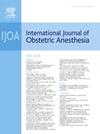Racial and ethnic disparities in postpartum pain: a systematic review
IF 2.3
3区 医学
Q2 ANESTHESIOLOGY
引用次数: 0
Abstract
Background
Racial and ethnic disparities in obstetric analgesia and anaesthesia exist globally. However, little is known about disparities in postpartum pain assessment, intensity, and treatment. These disparities are complex and may be influenced by interlinked factors including social determinants of health. We aimed to review the evidence of disparity related to pain in the postpartum period.
Methods
We conducted a systematic review to systematically summarise literature related to racial and ethnic disparity in postpartum pain frequency assessment, severity and opioid prescribing. Relevant observational studies were identified from a previous systematic review and supplementary reference screening.
Results
Eight observational studies involving 22,259 patients were included. All included studies were conducted in the United States (n=7) or the United Kingdom (n=1). Five examined pain after caesarean delivery, and three assessed all delivery modes. Studies showed disparities in reporting of pain, with higher pain scores reported by Black and Hispanic patients when compared with White patients. Black patients were also less likely to receive equivalent analgesic medication doses when compared with White patients.
Conclusions
Racial and ethnic disparities persist in pain frequency assessment, intensity and analgesic prescribing during the postpartum period. Further research is needed to elucidate the reasons underpinning these disparities, particularly the role of structural and institutional factors, to guide the development of equitable patient-centred approaches to minimise them.
产后疼痛的种族和民族差异:系统回顾
背景:在全球范围内,产科镇痛和麻醉存在着种族和种族差异。然而,对产后疼痛评估、强度和治疗的差异知之甚少。这些差异是复杂的,可能受到相互关联的因素的影响,包括健康的社会决定因素。我们的目的是回顾与产后疼痛相关的差异的证据。方法通过系统回顾,系统总结与产后疼痛频率、严重程度和阿片类药物处方的种族差异相关的文献。相关的观察性研究是从先前的系统评价和补充参考筛选中确定的。结果纳入8项观察性研究,共22259例患者。所有纳入的研究均在美国(n=7)或英国(n=1)进行。其中5人检查了剖宫产后的疼痛,3人评估了所有分娩方式。研究表明,在报告疼痛方面存在差异,黑人和西班牙裔患者报告的疼痛评分高于白人患者。与白人患者相比,黑人患者也不太可能接受等量的镇痛药物治疗。结论在产后疼痛频次评估、疼痛强度和镇痛药物处方方面存在种族差异。需要进一步的研究来阐明造成这些差异的原因,特别是结构和体制因素的作用,以指导制定公平的以患者为中心的方法,最大限度地减少这些差异。
本文章由计算机程序翻译,如有差异,请以英文原文为准。
求助全文
约1分钟内获得全文
求助全文
来源期刊
CiteScore
4.70
自引率
7.10%
发文量
285
审稿时长
58 days
期刊介绍:
The International Journal of Obstetric Anesthesia is the only journal publishing original articles devoted exclusively to obstetric anesthesia and bringing together all three of its principal components; anesthesia care for operative delivery and the perioperative period, pain relief in labour and care of the critically ill obstetric patient.
• Original research (both clinical and laboratory), short reports and case reports will be considered.
• The journal also publishes invited review articles and debates on topical and controversial subjects in the area of obstetric anesthesia.
• Articles on related topics such as perinatal physiology and pharmacology and all subjects of importance to obstetric anaesthetists/anesthesiologists are also welcome.
The journal is peer-reviewed by international experts. Scholarship is stressed to include the focus on discovery, application of knowledge across fields, and informing the medical community. Through the peer-review process, we hope to attest to the quality of scholarships and guide the Journal to extend and transform knowledge in this important and expanding area.

 求助内容:
求助内容: 应助结果提醒方式:
应助结果提醒方式:


